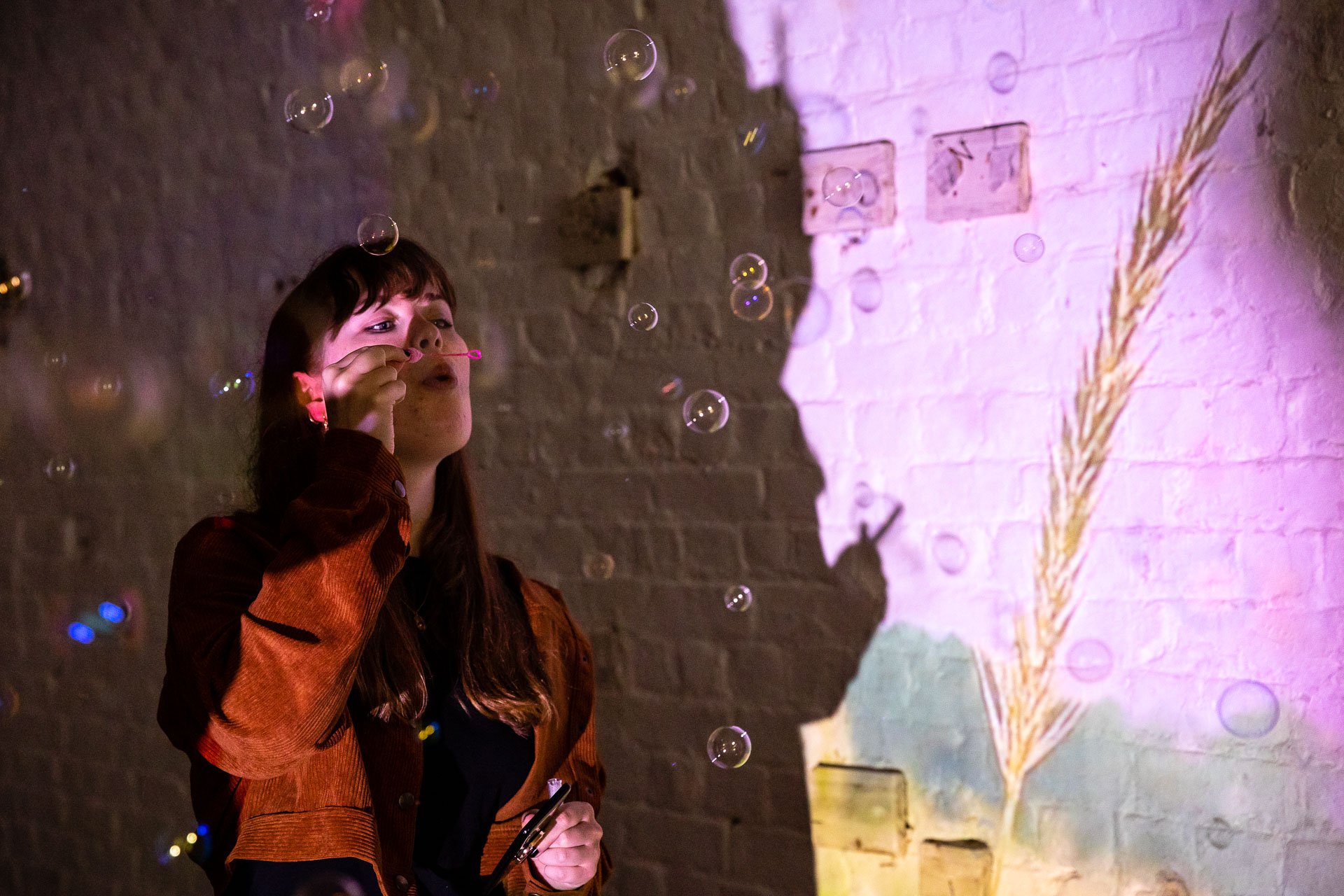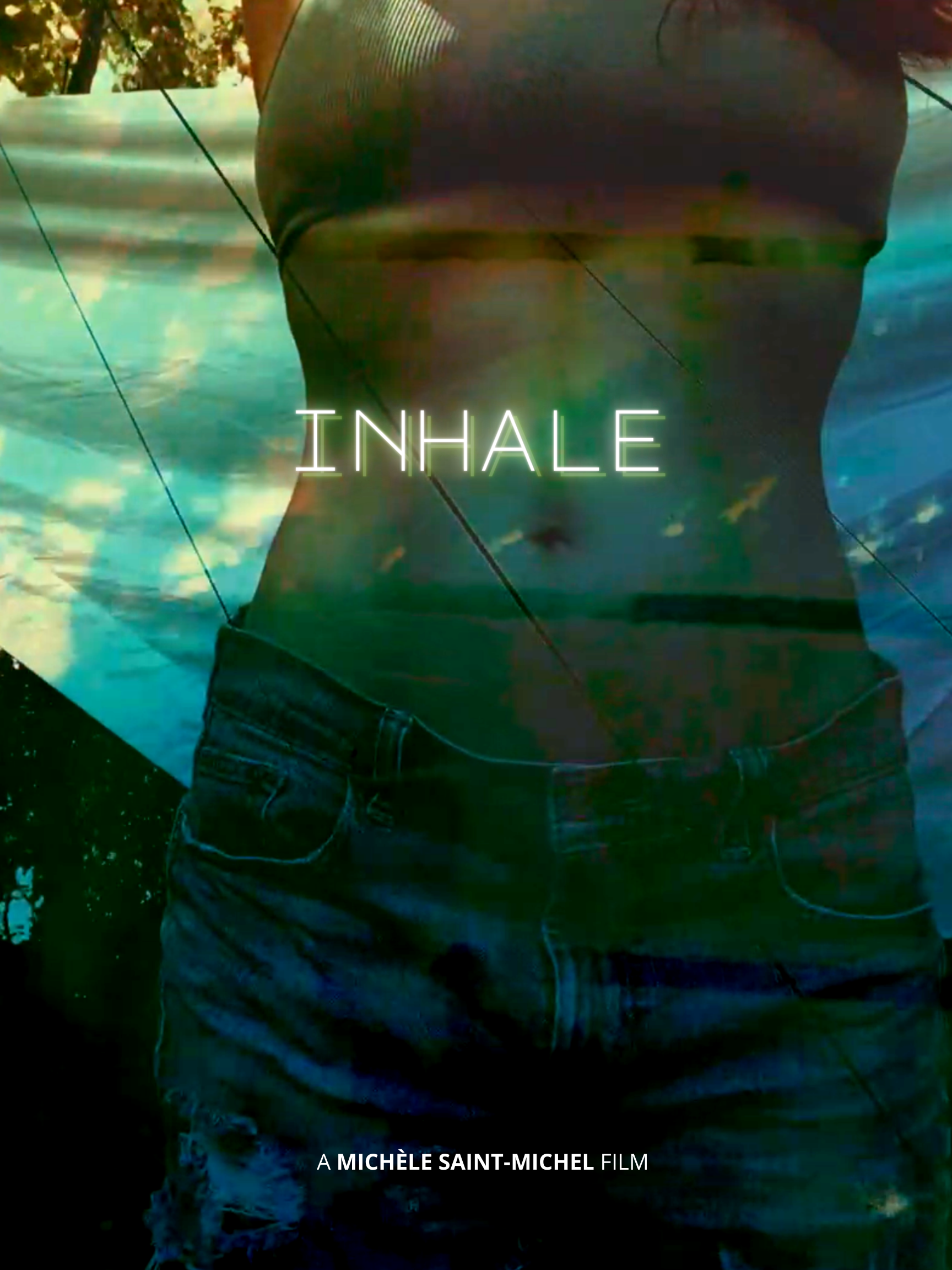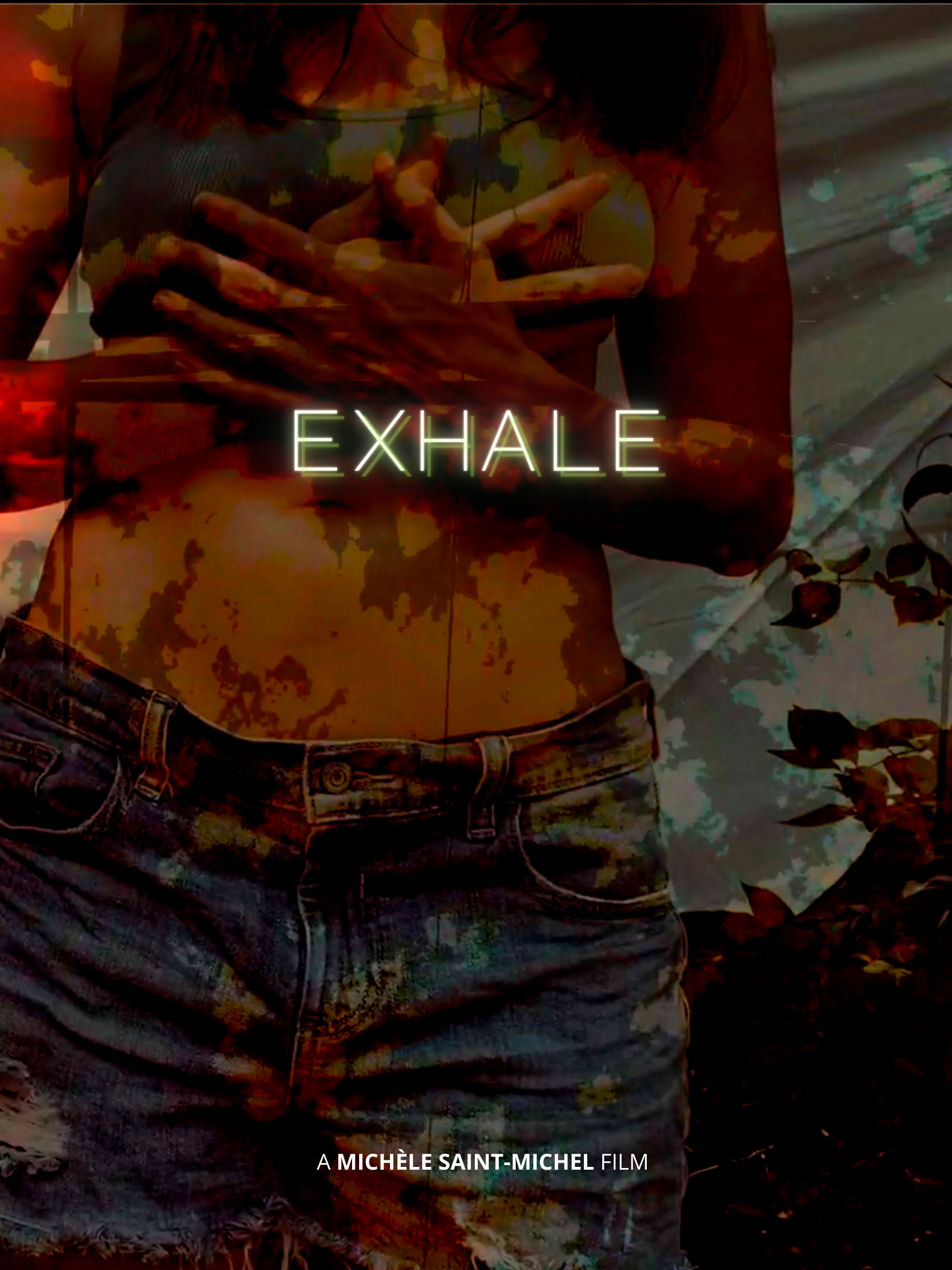Michèle Saint-Michel
Filmmaker, Intermedia Artist, and Poet
selected works
New and selected works by Michèle Saint-Michel. See more
Score-Making: Creative Prompts for Mapping Personal Experience through Sound
Bloomsbury Publishing (Forthcoming 2026)
Contributor: Michèle Saint-Michel
Point A, from A Map of All My Tender Places by Michèle Saint-Michel
For Score-Making by Jennie Gottschalk (Bloomsbury 2026)
Composer and writer Jennie Gottschalk developed Score-Making, a book commissioned by Bloomsbury that gathers text-based scores responding to themes such as Maps, Difficulties, and Necessities. The project expands the experimental music tradition of text scores into a broader field of embodied experience, inviting artists, composers, writers, and interdisciplinary practitioners to translate memory, interiority, and daily life into instruction-based works.
Saint-Michel’s contribution, A Map of All My Tender Places, appears in the “Maps” section. The work is not a map of landscape but of sensation, an affective cartography that traces tenderness as a distributed, living phenomenon rather than a fixed site. Emerging from a period of rupture, it uses Polaroid photography and poetic text to locate the body through touch, memory, and the quiet intensities of the everyday.
Rather than offering coordinates, the score invites a phenomenological orientation:
to feel rather than navigate,
to hold rather than resolve,
to treat image and instruction as apertures into embodied memory.
The work frames the instant photograph as both relic and ritual, susceptible to decay, altered by time, and capable of carrying affect in its emulsions and imperfections. Translated into score form, A Map of All My Tender Places becomes a companion rather than a directive, asking where the ache lives, where softness begins, and how tenderness might be encountered as method rather than sentiment.
This forthcoming publication positions Saint-Michel’s work in dialogue with an international cohort of contributors exploring how sound, score, and instruction can make the interior world legible without flattening it into narrative.
No Pattern Against User
hARTslane Gallery
2025
Axiogenesis by Michèle St. Michel
Single-channel film, digital HD video; Silent; Colour; 12m00s
In 2025, Saint-Michel presented three interconnected works for No Pattern Against User, curated by Josh Roberts for an international group exhibition at hARTslane Gallery in South London. The entangled works included Axiogenesis, a single-channel film exploring metaphysical optimism and quantum instability; Will to Power, a sculptural quantum poem utilizing diatomaceous earth and text; and Axiogenesis II, a quadraphonic sound piece fragmented across cassette tapes.
Curator: Josh Roberts
Gallery: hARTsland Gallery
Location: London, UK
Documentation: indexthumb
World Premiere: THE QUEST (2025)
The Quest, A Somatic Film by Saint-Michel | Brooklyn, NY
Film still from THE QUEST (2025), directed by Saint-Michel.
Premiering to a sold-out audience at Millennium Film Workshop in Brooklyn as part of The Poetic Lens screening series, THE QUEST is a striking new short film by artist-filmmaker Saint-Michel. Rooted in somatic filmmaking and choreographic intimacy, the piece unfolds like a post-breakup letter, read aloud beside a returned vinyl of Mal Waldron’s 1961 jazz album The Quest—which gives the film its name.
Film still from THE QUEST (2025), directed by Saint-Michel.
Shot in both digital video and hand-processed 16mm, THE QUEST captures 27 London-based artists performing somatic scores composed by Saint-Michel in 2024. These scores—ranging from tracing room borders with the eyes to counting heartbeats—were part of her project 21 Scores for Losing Yourself in a Body, an experimental invitation to explore embodiment and memory through movement.
This emotionally charged film launches the first installment of Saint-Michel’s series, Amor Fati—a multidisciplinary exploration of healing, longing, and the transformative power of the body in motion.
21 Scores for Losing Yourself in a Body [B-Side] (2024)
MICHÈLE SAINT-MICHEL. 21 Scores for Losing Yourself in a Body [B-Side], Film still. 2024.
16mm, hand-processed B&W film, digitally scanned with digital HD video; Stereo sound; Colour; 12m00s
Filmmaking is magical because it’s imbued with time, attention, and community. Artists’ film in particular is extraordinary because we often shrug the yoke of expectation in an attempt at expression cut close to the bone.
Working with celluloid film this year has brought a shift in my filmmaking practice toward an embodiment of the moving image. I’ve come to understand the camera not as extractive or as outward piercing, but instead as an envelope. The film camera as divine feminine opens to accept the light of the world before it. This subtle shift in perspective has pulled my filmmaking under the skin. I’ve brought it inside like laundry on the line when it starts to rain: a needful act, necessary, urgent.
This new, hand processed film features my work with 34 London-based artists performing 21 Scores for Losing Yourself in a Body. It’s superimposed over a single shot of clouds over London in May 2024. The film features a modular score (inspired by William Raban’s approach) by the award-winning composer Peter Flint.
21 Scores for Losing Yourself in a Body [Installation] (2024)
London artists perform a series of somatic choreographies. The focus on interiority and embodied experiences creates a palimpsest for the scores we keep in our bodies. Hand-processed 16mm film superimposed over long, single shots of the London sky.
Installation appeared in South London’s Laurie Grove Baths along with 6 silk organza prints 300cm x 100cm.
MICHÈLE SAINT-MICHEL. 21 Scores for Losing Yourself in a Body, 2024. 16mm, hand-processed B&W film, digitally scanned with digital HD video; Stereo sound; Colour; 23m01s. Installation view, Laurie Grove Baths, South London, New Cross, UK. Photo credit: Hanna Moon
21 Scores for Losing Yourself in a Body : : May 2024, 34 London-based artists performed a series of event scores based on somatic exercises and internal choreography. After learning about each artist and their current interests, I searched through the event scores to find an exercise to essentially bridge our practices. The overlaps were serendipitous and profound. I was frequently moved by the trust and daring of the creatives in the studio who allowed me to film the exercises digitally and on 16mm. My unorthodox approach was met with openness and a willingness to go there — sometimes way out there as you will see by some of the movements.
Axiogenesis (2024)
MICHÈLE SAINT-MICHEL. Axiogenesis [Installation], 2024.
Multi-channel film, digital HD video; Stereo sound; Colour; 12m00s
In Axiogenesis, determinism and causation are examined from both quantum and poetic views. Axiogenesis, or the philosophic idea of existential optimism, is held up to the light and used as a prism to deconstruct the more common future-focused anxiety that is often experienced throughout our daily lives. The “both/and” is simultaneously fixed and flexible and is a necessary positionality to engage with these quantum works where the poiesis of meaning can be recalculated and reconfigured with each passing moment.
A passage from Simone Weil and a poem from the Godfather of San Francisco Beat poetry, Kenneth Rexroth. In the poem, the speaker contemplates their life with an ephemeral existentialism in a triad of unfolding eras; imagining their life unfold before them as a child, experiencing all-consuming eros as an adult, and backwards processing a life from the far side of the hill. Dusted with fossilised micro-algae skeletons, the sculpture holds up geological temporalities creating embodied perception and centring our humanity through the inevitable biophilic.
Will to Power (2024)
MICHÈLE SAINT-MICHEL. Will to Power, 2024. Acrylic, diatomaceous earth (fossilized micro-algae skeletons), poetry. Installation view
[Things don’t happen unless something makes them happen.]
Kenneth Rexroth was influential to a number of midcentury American poets associated with the San Francisco Renaissance and was known, in his lifetime, as “Godfather” of the Beats—he organized and emceed the Six Gallery reading in 1955 where Allen Ginsberg first read “Howl.”
Here, one of Rexroth’s erotic poems is brought into dimensional space in this sculptural configuration of the piece. In the poem, the speaker considers their life in a triad of unfolding eras; imagining their life before them as a child, experiencing love as an adult, and looking back at the life one has lived in advanced age.
In Saint-Michel’s latest body of work, she examines determinism and causation from both quantum and poetic views. Axiogenesis, or the philosophic idea of existential optimism is held up to the light and used as a prism to deconstruct the more common future-focused anxiety that is often experienced throughout our daily lives. The “both/and” is both fixed and flexible and is a necessary positionality to engage with these quantum works where the poesis of meaning can be recalculated and reconfigured with each passing moment.
Possible paradigms: autonomisation, relation, biophilia; emergence, complexity, process, individuation, (auto)poiesis; ephemeral existentialism, disintermediation; direct perception, embodied perception, perception-as-action; speculative pragmatism, speculative realism, radical empiricism; meditation, virtualization; ecology of practice, media ecology; technicity; micropolitics, biopolitics, ontopower, the inexorable power of revolt.
MICHÈLE SAINT-MICHEL
Will to Power, 2024
Acrylic, diatomaceous earth (fossilized micro-algae skeletons), poetry. 100 cm x 40 cm x 40 cm.
Installation view
In danger, the sea-cucumber divides itself in two (2023)
Filmmaker MICHÈLE SAINT-MICHEL. In danger, the sea-cucumber divides itself in two (2023). 9 min. Color, Silent. Installation view, Hypha Studios, 2023
Filmmaker MICHÈLE SAINT-MICHEL. In danger, the sea-cucumber divides itself in two (2023). Michèle Saint-Michel, 9 min. Color, Silent. Film still.
To defend against predators, the holothurian (or sea-cucumber) ejects its intestines and makes a rapid exit. This is the moment of fight or flight (fawn or freeze) recreated for this work. In these mere fractions of moments, we are irrevocably divided into blissful ignorance and a haunting seed of knowledge that forever rests heavy in our guts. We are divided into a before and an after. As Wisława Szymborska writes, we are divided “into flesh and a broken whisper.”
This work premiered at Hypha Studios in Stratford, London E20 as part of the Loess Collective’s show “Taste the Difference” in February 2023.
109 Lockets (2023)
MICHÈLE SAINT-MICHEL. 109 Lockets (2023). Detail view.
MICHÈLE SAINT-MICHEL. 109 Lockets (2023). Installation view.
Filmmaker MICHÈLE SAINT-MICHEL. How to Hide This (2023), Sculptural film. 22m, Color, Silent. Installation view
In response to UK-based researcher and advocate, Karen Ingala Smith’s Counting Women project, I created a range of works reflecting on gender-based violence. They include sculptural films, including Each Memory is a Room (2023) and How to Hide This (2023), which is screened within a hollowed-out copy of Plato's Phaedo (On the Soul).
In addition, the collection features poetic objects such as Concealer (2023), a series of mirrored compacts opened at 225°, and 109 Lockets (2023), a collection of 109 individual lockets on chains, each representing a woman killed by a man in the UK in 2022. These lockets are filled with an assortment of words extracted from the pages of Plato's Phaedo, leaves, seeds, and pantry staples, presented as a poignant assemblage.
This cycle of work culminated with the release of the poetry collection, Liner Notes for Getting Out Without Catching Fire: Deluxe and Standard editions (Bad Saturn 2023).
Concealer (2023)
Installation
Visitors interact with Concealer (2023) at Hypha Studios in East Village, London. 36 compact mirrors opened to 225°. 180x180cm.
[[even a stopped clock is right twice a day]] (2021)
Projected film for opposing walls, bubbles. 16 min
Featuring a qudraphonic score by Dr. Sophie Stone
MICHÈLE SAINT-MICHEL. [[even a stopped clock is right twice a day]] (2021). Installation view in Fort Amherst, Surrey, UK. 2021
MICHÈLE SAINT-MICHEL. [[even a stopped clock is right twice a day]] (2021). Installation view in Surrey, UK. 2021
The collaborative audio-visual project [[even a stopped clock is right twice a day]] by artists Michèle Saint-Michel and Sophie Stone explores how we create order in our lives during times of chaos. The work asks the audience to view opposing screens simultaneously and interrogate the desire to confirm synchronisation. The effervescent visuals showcase an endlessly primping, mask-like visage in muted pastels of coral pinks and aqua blues. The audio is filled with birdsong and rain. At the center of it all: a vivid, driving countdown clock.
The piece premiered at the Grand Magazine in Fort Amherst, Chatham, Kent, England. It was also screened at the 2022 Music and/as Process Conference: Music and Interdisciplinary Practice at the University for the Creative Arts - Farnham Campus.
The Immortal Charlie Parker (2021)
Audio poem, 19 min
Artist Michèle Saint-Michel fuses poetry and music with news reportage in her powerful audio piece, The Immortal Charlie Parker. In it, she recounts her experience of reconnecting with a childhood friend during the early stages of the pandemic.
Immortal Charlie Parker (2021). Audio piece, 19 min. Cover image for Disembodied Voices, Lucy Cavendish School, University of Cambridge
In The Immortal Charlie Parker, artist Michèle Saint-Michel tells an intimate story which, she writes in her email to us, is about ‘safety, trust, and inherent worth’. The spliced audio of radio pronouncements and news pieces transports us through her experiences of the pandemic, framing the fear of vulnerability in this tentative connection. It captures the strangeness of our times through a personal prism, one which has at the forefront a question: Are we now only dangerous to each other? The phrase ‘a trauma response’ punctuates the poem repeatedly. Those with PTSD and/or experiences of trauma will know well how the pandemic has intersected with our wounds.
—Sumaya Kassim, Disembodied Voices Co-editor,
University of Cambridge
The Hole (2021)
The Hole (2020). 4 min. Film still
The Hole is a poetry film by Michèle Saint-Michel in collaboration with Cypriot poet Nora Nadjarian. Nadjarian reads two poems in the piece, “Digging” and “The Hole” from which the title of the film takes its name. Visually, we travel across three planes: deeper into a forest, deeper into the sea, and deep into the Earth’s core. We travel past the Earth’s crust, reaching the mantle, past the water’s surface and the tree line. We move deeper: punctuated by malleable areas of semi-solid magma, noticing fish, and the forest’s canopy. We reach the center of the Earth. It is a hot, dense core; dreams and memories have room to blossom here, creating light in the darkness. Note the English word for “touch” is repeated in Armenian (դպչիլ), German (berühren), French (toucher), and Greek (αγγίζω). Nadjarian narrates the film.
About Nadjarian
Nora Nadjarian is an Armenian–Cypriot poet and short story writer. She writes in English and Armenian, as well as Greek. Her writing mostly centres on the island of Cyprus, especially the partition of Cyprus into North and South, though there are numerous works of universal themes.
Abyss Triptych (2020-21)
the abyss welcomes us (2020). Film still
the abyss doesnt divide us (2020). Film still
the abyss surrounds us (2020). Film still
Abyss Triptych is an experimental, three-channel installation film and includes the abyss welcomes us, the abyss doesnt divide us, and the abyss surrounds us. The films express a Melvillian sense of much activity without substantial progress. US Poet Laureate Joy Harjo says that ruin and reinvention are inseparable. But must we give everything like Captain Ahab, or half of our body like the holothurian of Wisława Szymborska’s poem ‘autonomy’?
“In danger, the holothurian cuts itself in two. / It abandons one self to a hungry world / and with the other self it flees. // It violently divides into doom and salvation, / retribution and reward, what has been and what will be.” What are we willing to sacrifice for advancement and how many times can we cut ourselves in two? How much healing can one body take? As Szymborska says: “We, too, can divide ourselves, it’s true. / But only into flesh and a broken whisper. / Into flesh and poetry.”
How will you divide yourself? What are you willing to leave behind?
the abyss welcomes us was named an Official Selection in the 2021 Cadence Poetry Film Festival in Seattle, Washington.
PTSD Suite (2020-21)
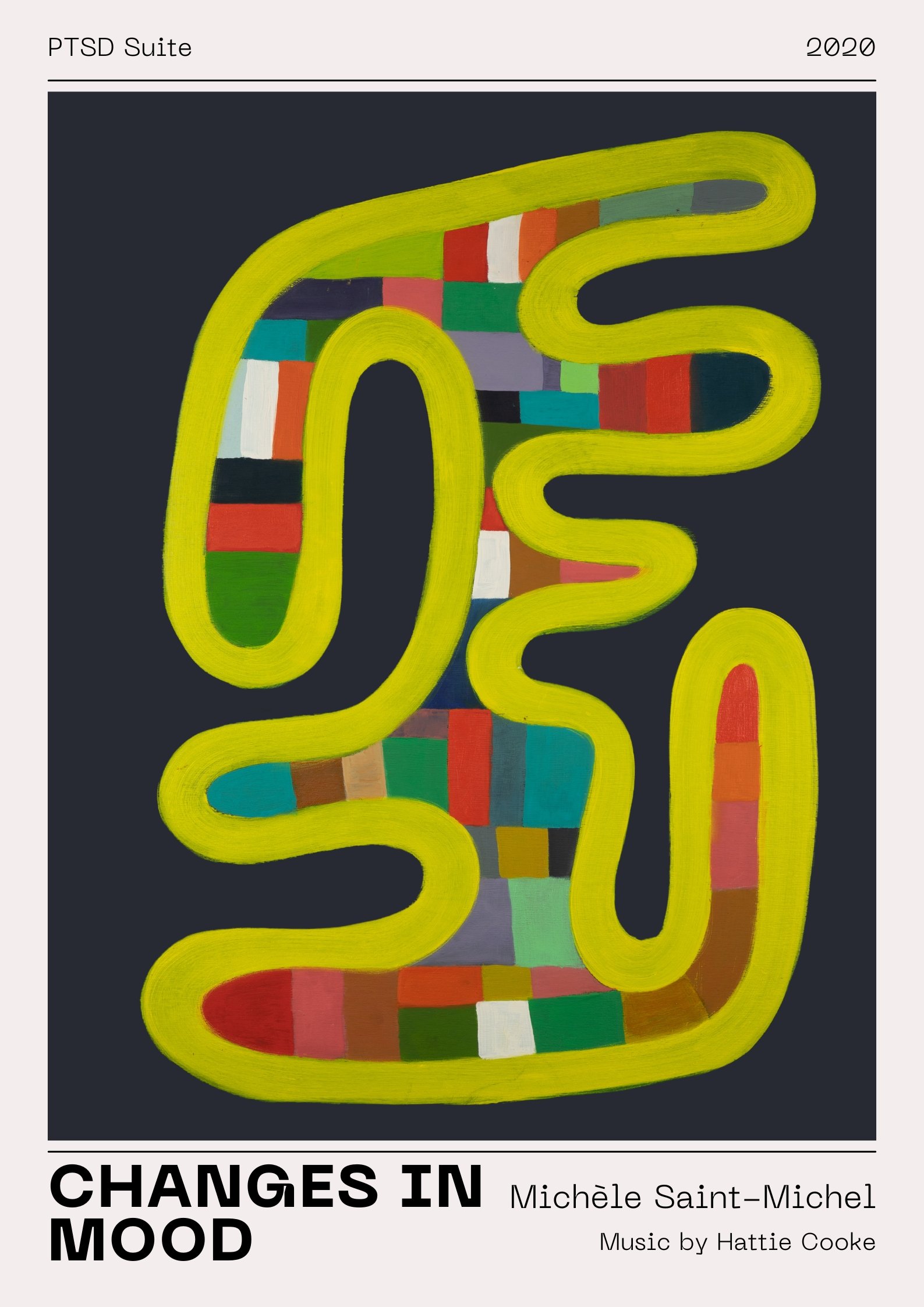
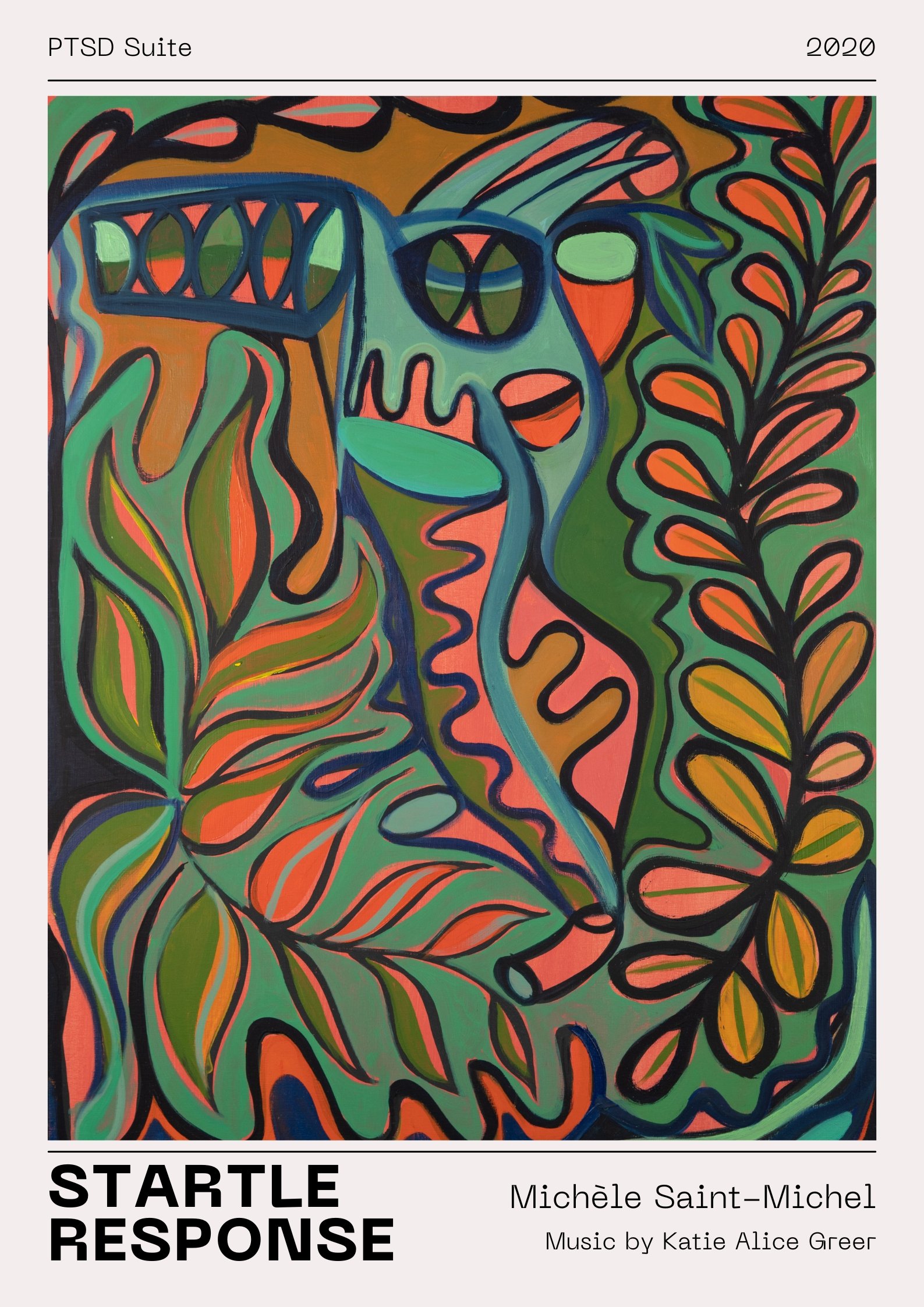
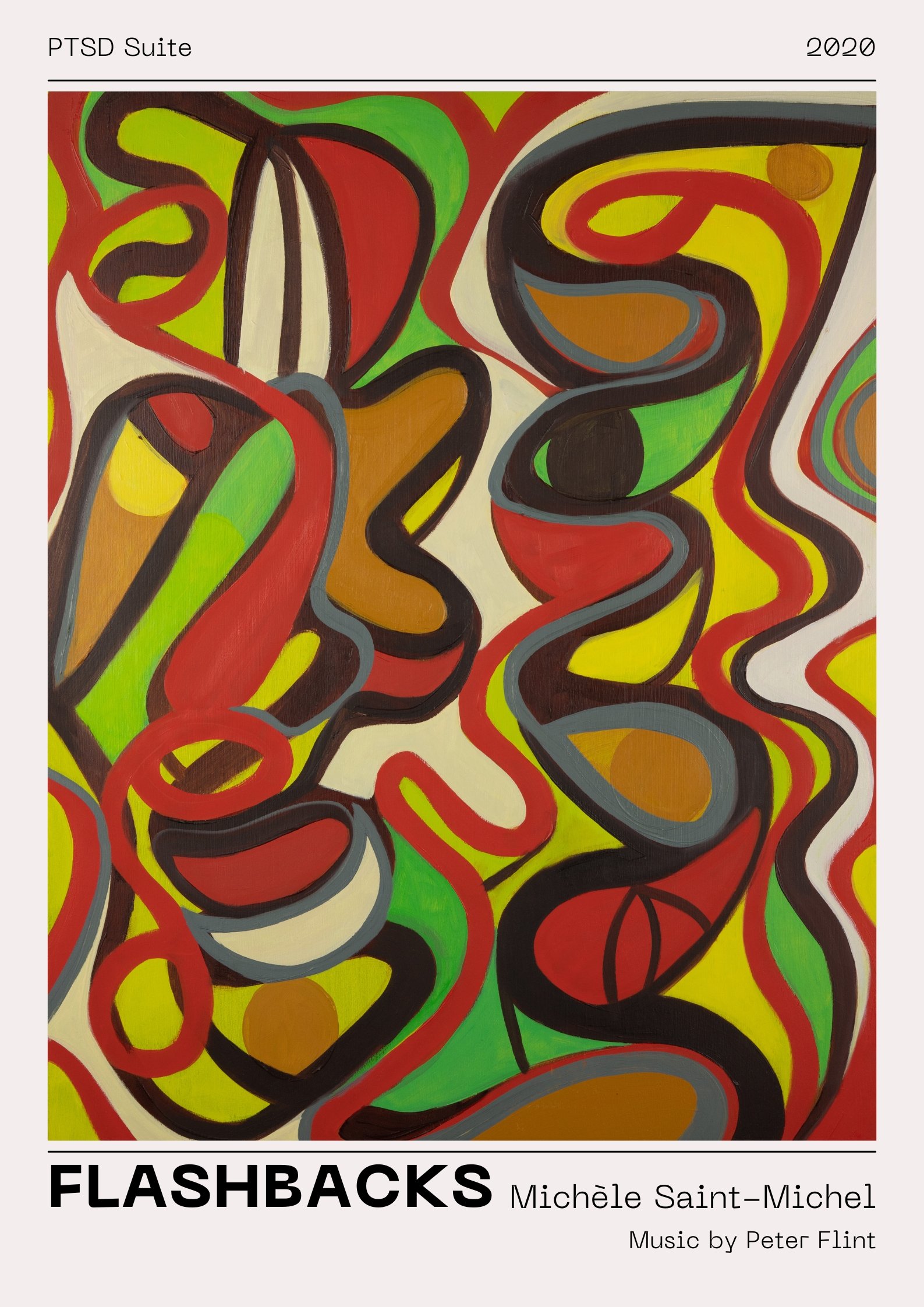
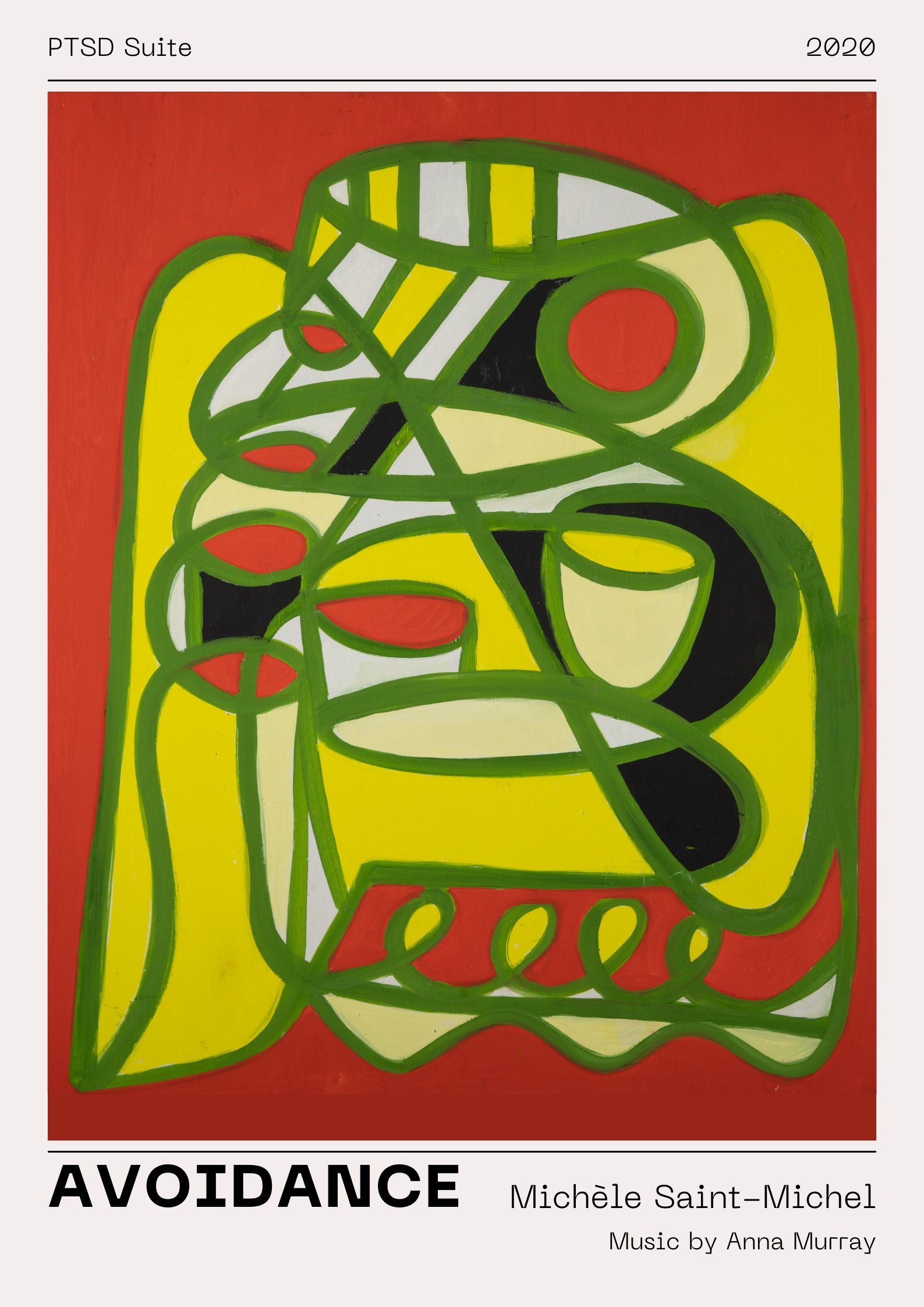
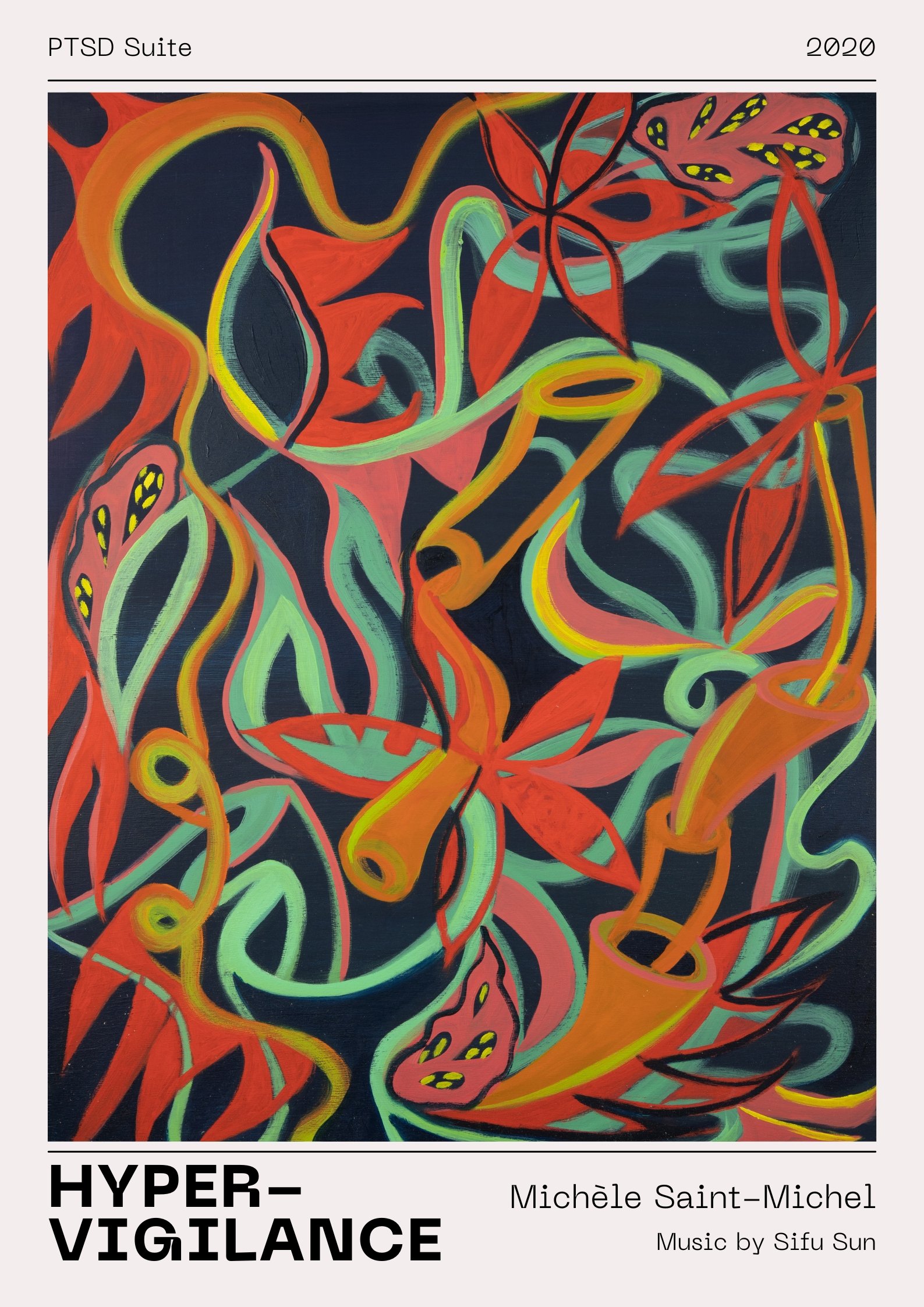
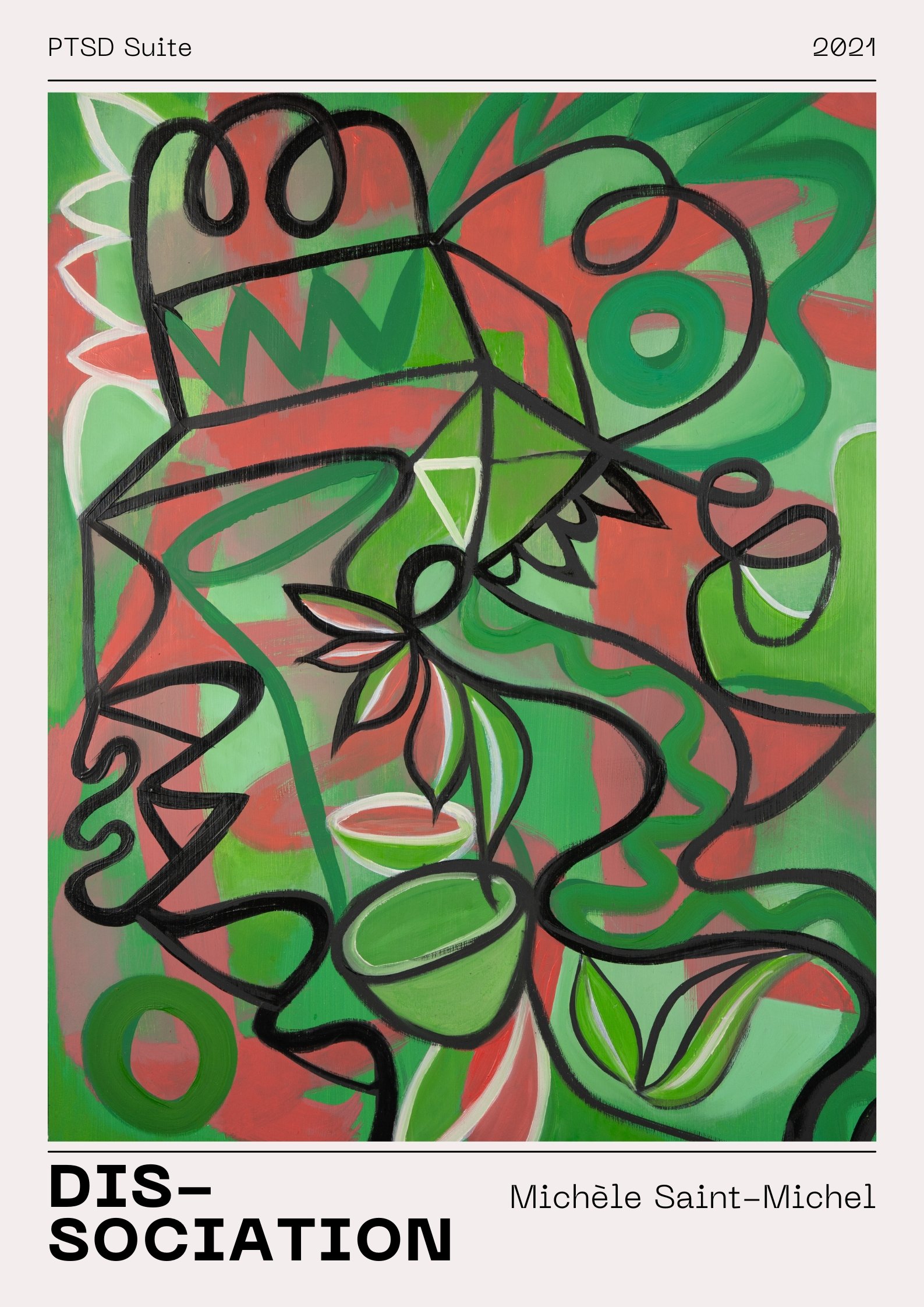
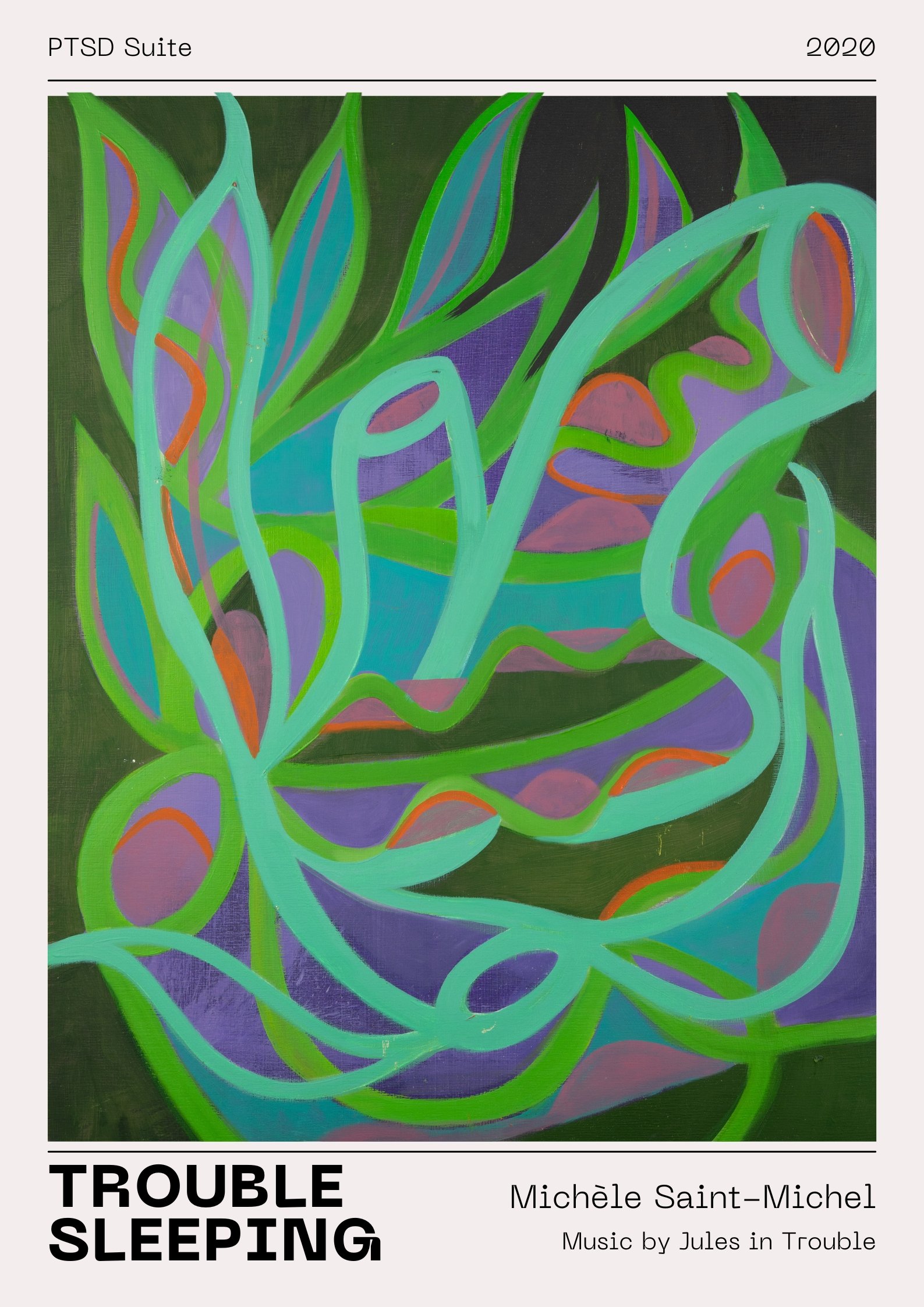
Borrowing a narrative storytelling approach from director Lizzie Borden, the PTSD Suite uses vignettes, allegories, poetry, and sometimes dictionary entries to create a liminal world at the center of many overlapping Venn diagrams.
The PTSD Suite is a collection of short experimental films that explore the symptoms and lived experience of Post-Traumatic Stress Disorder. Each film is named after a common symptom of PTSD. Saint-Michel teamed up with a different experimental musician and / or composer for each piece. While each piece sounds unique, all are underpinned by a familiar pattern: the Fibonacci sequence. The films reuse much of the archival footage and analog textures, creating an uncanny experience of uncertain deja-vu, an effort to mimic an experience of PTSD for the viewer.
TROUBLE SLEEPING had its Mexican premiere as an Official Selection at the Mexican Institute of Cinematography in Mexico City, Mexico, April 2022.
HYPERVIGILANCE had its Spanish premiere as an Official Selection at the Biodedromo Film Festival in Bilbao, Spain, October 2021.
STARTLE RESPONSE had its US premiere as an Official Selection at the Prismatic Ground Experimental Documentary Film Festival in association with the Maysles Documentary Center in NYC, April 2021.
Most of the seven short films screened at the Great Wave Festival in Berlin, Germany in 2020.
inhale / exhale (2020)
Multi-channel installation
The inhale/exhale film series is in conversation with the work of film diarist Anne Charlotte Robertson and the self-portraits of artist Eleanor Antin. When played together, the main figure flits from screen to screen in a dizzying choreography, existing everywhere and nowhere.
"The struggle of all artists, but the womxn artist in particular, to show up and allow ourselves to be seen authentically in artistic terms, in nurturing roles, as sexual beings, as multi-dimensional stardust wrapped in flesh and bone—it’s all a lot to be going on with. I hope some of that nuanced multidimensionality comes through in this work."
Transmettre (2021)
Named an Official Selection for the 20 seconds of 2020 for the Dérapage festival (22 years and running) in Montreal, Canada.
Transmettre, created specifically for the 2020 In 20 seconds artists’ call from Dérapage, is an experimental, non-narrative work exploring connection, transmission, and quantum entanglement. The piece attempts, by the force of its atmospheres, to make viewers see with new eyes the year that sculpted the “Before times” from the ether.
Transmettre (2020). Film Still.
The piece includes this declaration: We must begin to hold competing ideas as distinct, yet inextricably interconnected. We must make space for complexity, nuance, and data points. We must find strength in our flexibility. Recognize that our binaries both do not define us and-both/and are essential. We must become more comfortable with our discomfort and increasingly attuned to its arrival.
Like water, we are now challenged to become persistent, erosive, and devastating; AND yielding, restorative, and life-giving. Our storytelling must operate with this same multiplicity and multidimensionality. It must move atomically. We must tell stories that can penetrate bone and be absorbed directly into the marrow. Our approach must operate via a matrix of understanding and unlearning: a topography, a geography, and an oral history. Works must be taken in like pulling down the washing when it starts to rain. We must hold them under our own skin, at arm’s length, and like someone we hate who’s come to us in tears. The work must become an unsolvable enigma and we must share every answer.
Other Collaborations
Interior: an Exquisite Corpse film Multi-Artist Collaborative Film (2020)
Interior: an Exquisite Corpse film, a collaborative project initiated by artist Sapphire Goss during the COVID-19 lockdown. Taking inspiration from the surrealist exquisite corpse method, each contributor would see the last few seconds of the previous film in the sequence and continue in their own way on the theme of Interior. The film was Screened by the UK-based magazine Moving Image Artists and the Strangelove Moving Image Festival in Kent, UK.
See it: https://movingimageartists.co.uk/2020/11/12/interior-strand-b/
On Shawano Lake (2021)
On Shawano Lake is a poetry film based on the poem of the same name by American poet Lora Keller.
The film plays with the horizontal line, representing the horizon where the water meets the sky and the shoreline that divides the water from the land. We journey into color and fragmentation in the style of color field paintings.
The film shifts tonally to the surreal when the speaker mentions imagination. A pattern of triplicates plays on the three children in the poem and on the classic children’s circular rhyming song, "Row row row your boat" that's often sung as a round.
Keller narrates the film.
Vile Figs (2021)
Vile Figs is a poetry film based on the British poet, Luke Kennard's poem of the same name. On its face this poem considers our complicated relationship with technology and surveillance. More deeply, the work explores notions of belonging and care. At the heart center is the astounding question: is there a point where we stop extending compassion?
The film was an Official Selection at the Monologues and Poetry International Film Festival in Vallejo, California, and at the Art + Lit Laboratory, Midwest Video Poetry Festival in Madison, Wisconsin in 2021.
Kennard narrates the film.

















